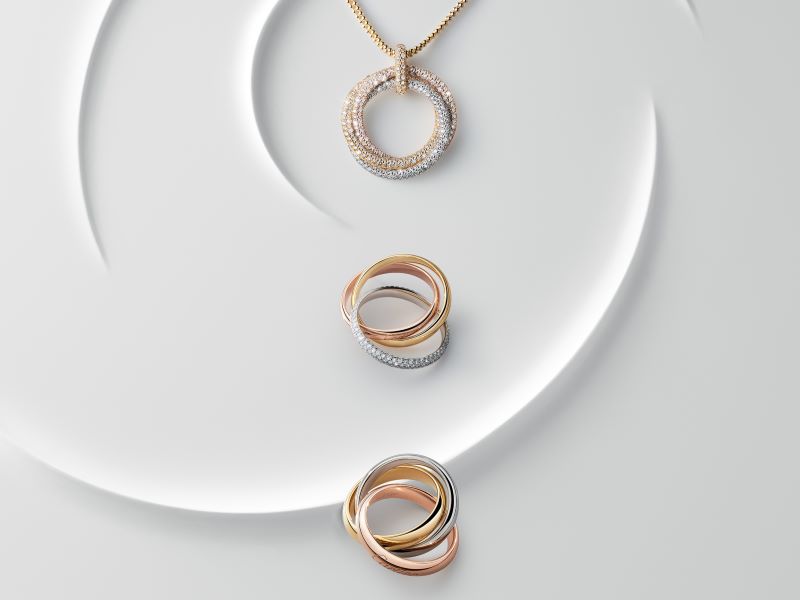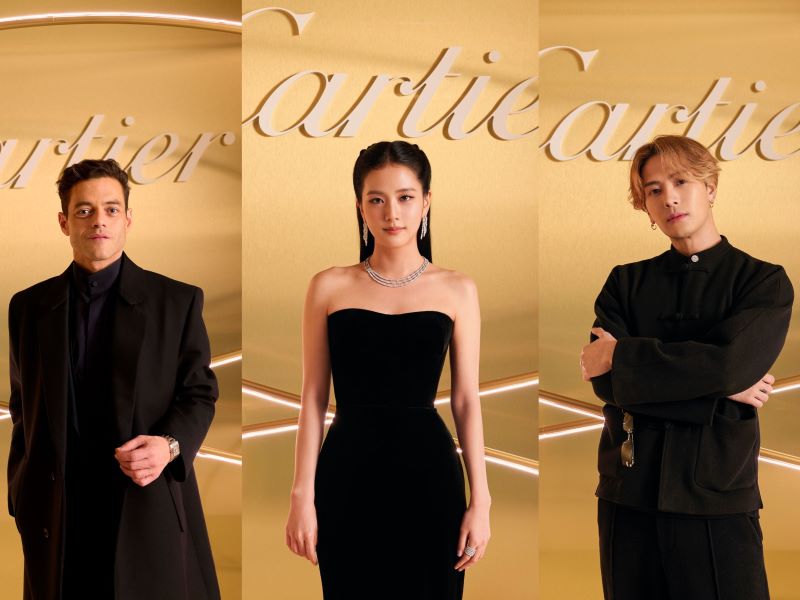British rapper Labrinth and Australian singer Sia team up to delight guests in Paris (All photos: Cartier)
“Times have changed
And we’ve often rewound the clock
Since the Puritans got a shock
When they landed on Plymouth Rock.”
— Cole Porter
It is hard to believe that a small, simple yet striking piece of jewellery — composed of three intertwined bands of rose, yellow and white gold — continues to captivate the world 100 years after its debut. And yet the story of the Trinity remains compelling as ever. Originally conceived by Louis Cartier in 1924, the Trinity was an anomaly at the time it was first unveiled.
The Roaring ’20s was in full swing and the fashions then exuded all the glamour, glitter and sense of liberty embodied by a scarred but hungry-for-life world after the ravages of the Great War. Women too were beginning to shake off societal shackles, cutting their hair, emancipating their wardrobes and entering the workforce. Strict class boundaries were also beginning to blur and while it would be a good decade more before Cole Porter wrote his famous ditty of Anything Goes, its lyrics — which spoke of changing times to challenging the norms of the era — summed up the zeitgeist perfectly.
Historians and chroniclers of style would also tell you the rules for wearing jewellery then was simple: Pile it on! It was the Jazz Age and long necklaces that flattered the flapper, like a fringed lariat or sautoir, were all the rage. Brooches, bracelets, bangles and rings had to be oversized, ornate and preferably ornamented. The nascent Art Deco style was en vogue and it was still the golden years when royal families, from England to India, would visit the grandest jewellers in Paris’ Place Vendôme (chief of which, it has to be said, was Cartier) to commission superlative stunners. Hence, the debut of the Trinity, a unisex piece of jewellery and as pure in concept and design as can be, remains one of the major — to borrow modern-day parlance — disruptors in the history of human adornment.
“What I can say is that the Trinity looked like a big surprise at the time for traditional clients of Cartier,” says Pierre Rainero, the house’s revered image, style and heritage director. “In the early 1920s, Cartier was seen as the jeweller of kings and queens. Their Majesties would propose only unique creations, using important stones for exceptional pieces of jewellery for very important ceremonies. So, to suddenly see something that simple in Cartier’s windows ... well, that was really unexpected.
![]()
“It is also interesting to remember how there was a struggle or war even, at the beginning of the 20th century, on [the tenets of] creation and creativity. The Austrian modernist architect Adolf Loos had published a seminal essay criticising ornamentation in objects. Cartier, however, has always maintained that balance [is paramount] and every element has its allotted role to play in the final perception. So, the Trinity definitely adheres to both aspects.”
The Trinity’s three bands made using three precious metals — white gold has since replaced the original platinum — offer up an infinite array of possible interpretations. To the spiritual, it could represent the Holy Trinity. To traditionalists, it speaks of love, friendship and fidelity. In fact, the Trinity remains a popular choice of wedding ring in France until today. And to those always dreaming of what the future holds, the three entwined circles could represent eternity, infinite possibilities (rounded loops having no beginning, middle or end) or, as believed in many cultures, the perfect symbol of wholeness and unity. Even scientists would not disagree that highly symmetric circles are perfection itself, offering equidistant points when cut from core to circumference.
“I call it mysterious and magical,” Rainero says. “The Trinity is a mystery to those who wear it, wondering how it is made and how the three rings marvellously attach each to the other. It is also very playful and our clients are always amazed at how it can recompose from three parts into one snug ring. This is but one aspect of Trinity’s mystique.”

Those who delve into the Trinity’s star-studded past — the iconic ring counts Diana, Princess of Wales; Alain Delon, Grace Kelly, Cary Grant and, in more recent history, Kylie Jenner, among its legion of fans — would not fail to chance upon one name in particular: Jean Cocteau. The great French poet and playwright famously loved wearing two Trinity rings on his little finger. Parisian literary myth likes to cite how he took to wearing the two rings together as a daily reminder of lost love and friendship after Raymond Radiguet, his protégé and purported lover, died unexpectedly at the age of 20.
What is undeniable is that the tragedy shattered Cocteau to the point he could not even bring himself to arrange or attend the funeral, leaving it to Coco Chanel, who had to step in to oversee things. Some sources even posit how it was this very incident that triggered Cocteau’s infamous addiction to opium.
Rainero, however, takes this opportunity to set the record straight. “Based on our archives, Cocteau only purchased the ring in the 1930s, years after Cartier introduced Trinity. But I understand facts sometimes get blurred with time. This is also, I think, how legends are created.”
Fast-forward 100 years, Cartier has freshly interpreted the symbolic circles into an exciting cushion-shaped collection of rings, bracelets and pendants. Now with softly-squared edges — no doubt evoking other Cartier icons like the Tank and Santos — the additions to the Trinity family look set to play their part in helping tell new and unforgettable stories of love, friendship, memorable occasions and family. “Every field of expression, in terms of precious objects, is welcomed by Cartier as long as its value can be expressed,” Rainero explains. “And jewellery is a symbolic projection of important life events, whether it is an attachment to someone or a reminder of a special moment. It is also one of the most intimate objects we can wear. It is in constant contact with our body, thus creating a relationship. This is unlike clothes, which may be changed sometimes up to several times a day, but not jewellery which stays with and on you longer than most things.”

Circling back to the subject of the centenary celebrations, Cartier naturally went to town with the number “3”, holding back-to-back parties in New York, London and Paris, where the three brothers — Louis, Pierre and Jacques Cartier — settled and went on to establish three “temples” of the maison: on Fifth Avenue, New Bond Street and rue de la Paix, respectively. The culmination was held in the Neo-Classical Petit Palais, built by the great Charles Girault in the glamorous Beaux-Arts style.
Illuminated in scarlet for the night, in tribute to the maison’s signature shade, a megawatt guest list was drawn up to befit the monumental occasion. All five stars of the Trinity 100 campaign — Jisoo of Blackpink fame, singer Jackson Wang, rapper Labrinth, and actors Paul Mescal and Yara Shahidi — were in attendance, together with other Cartier global ambassadors and friends of the house, such as Rami Malek, Jake Gyllenhaal, Monica Bellucci, Sofia Coppola, Vanessa Kirby and Emma Corrin.
Champagne flowed all night long while those privileged to be present were treated to special performances by Labrinth, Sia, Diplo and La Horde, even as they danced in the shadow of Antonin Mercié’s monumental bronze cast Gloria Victis. How fitting then that, 100 years on, the story of the Trinity is gloriously retold in the city where it all started. What was that popular saying about life again? Oh yes, it comes full circle.
Watch the video below:
This article first appeared on Feb 26, 2024 in The Edge Malaysia.


